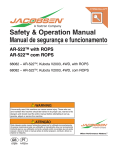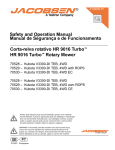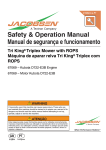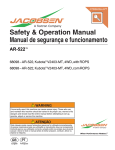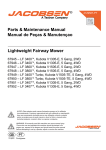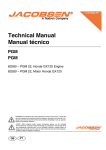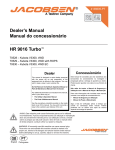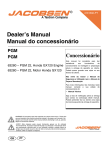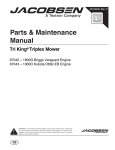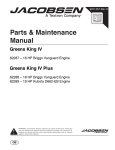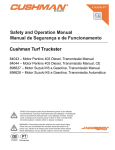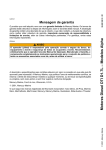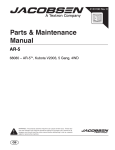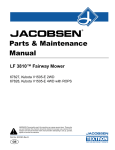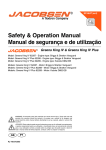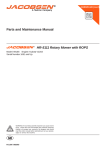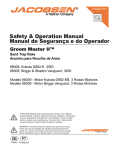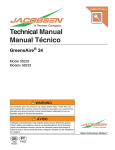Download warning - Jacobsen
Transcript
4102144-Rev A-PT Safety & Operation Manual Manual de segurança e de utilização Super LF 1880™ Fairway Mower Máquina de Cortar Grama Super LF 1880™ Fairway 67923 – Kubota D1105-E, 2WD 67924 – Kubota D1105-E, 4WD 67938 – Kubota D1105-TE, 4WD WARNING:If incorrectly used, this machine can cause severe injury. Those who use and maintain this machine should be trained in its proper use, warned of its dangers and should read the entire manual before attempting to set up, operate, adjust or service the machine. AVISO: Esta máquina pode causar ferimentos graves se for utilizada incorrectamente. A pessoa responsável pela sua utilização e manutenção deve ser previamente instruída para a sua utilização correcta, avisada sobre os perigos que ela pode causar e deve ler todo o manual antes de tentar preparar, conduzir, afinar ou reparar a máquina. GB PT CONTENTS 1 1 2 2.1 2.2 3 3.1 4 4.1 4.2 4.3 4.4 CONTENTS Contents Safety Operating Safety.................................................. 3 Important Safety Notes ........................................ 4 Decals Decals.................................................................. 5 Controls Icons .................................................................... 6 Controls ............................................................... 8 Opening The Hood .............................................. 9 Steering Console Cover ....................................... 9 5 5.1 5.2 5.3 5.4 5.5 5.6 5.7 5.8 5.9 5.10 Operation Daily Inspection ................................................. 10 Interlock System ................................................ 10 Operating Procedures ....................................... 11 Starting .............................................................. 12 Stopping / Parking ............................................. 12 To Drive / Transport ........................................... 13 Hillside Operation .............................................. 13 Mowing .............................................................. 14 Towing / Trailering ............................................. 14 Daily maintenance ............................................. 15 Proposition 65 Warning Engine exhaust from this product contains chemicals known to the State of California to cause cancer, birth defects, and other reproductive harm © COPYRIGHT 2002, TEXTRON INC. “All rights reserved, including the right to reproduce this book or portions thereof in any form”. All information in this publication is based on information available at time of approval for printing. Textron Golf, Turf & Specialty Products reserves the right to make changes at any time without notice and without incurring any obligation. LITHO IN U.S.A. 2-2003 GB-2 SAFETY 2 2.1 2 SAFETY OPERATING SAFETY ______________________________________________________ ! WARNING EQUIPMENT OPERATED IMPROPERLY OR BY UNTRAINED PERSONNEL CAN BE DANGEROUS. Familiarize yourself with the location and proper use of all controls. Inexperienced operator’s should receive instruction from someone familiar with the equipment before being allowed to operate the machine. 1. Safety is dependent upon the awareness, concern and prudence of those who operate or service the equipment. Never allow minors to operate any equipment. 8. Never operate equipment that has been modified, does not meet factory specifications, or is without decals, guards, shields, discharge deflectors or other protective devices securely fastened in place. 2. It is your responsibility to read this manual and all publications associated with this equipment (Parts and Maintenance Manual, Engine Manual, accessories and attachments). If the operator can not read English it is the owner’s responsibility to explain the material contained in this manual to them. 9. Never disconnect or bypass any switch or interlock. 3. Learn the proper use of the machine, the location and purpose of all the controls and gauges before you operate the equipment. Working with unfamiliar equipment can lead to accidents. 4. Never allow anyone to operate or service the machine or its attachments without proper training and instructions; or while under the influence of alcohol or drugs. 5. Wear all the necessary protective clothing and personal safety devices to protect your head, eyes, ears, hands and feet. Operate the machine only in daylight or in good artificial light. 6. Inspect the area where the equipment will be used. Locate and remove all debris in the operating area before using equipment. Beware of overhead obstructions (low tree limbs, electrical wires, etc.) and also underground obstacles (sprinklers, pipes, tree roots, etc.) Enter a new area cautiously. Stay alert for hidden hazards. 7. Never direct discharge of material toward bystanders, nor allow anyone near the machine while in operation. The owner/operator can prevent and is responsible for injuries inflicted to themselves, to bystanders and damage to property. 10. Carbon monoxide in the exhaust fumes can be fatal when inhaled. Never operate the engine without proper ventilation. 11. Fuel is highly flammable, handle with care. 12. Keep the engine clean. Allow the engine to cool before storing and always remove the ignition key. 13. Disengage all drives and engage parking brake before starting the engine (motor). Start the engine only when sitting in operator’s seat, never while standing beside the unit. 14. Equipment must comply with the latest federal, state, and local requirements when driven or transported on public roads. 15. Never use your hands to search for oil leaks. Hydraulic fluid under pressure can penetrate the skin and cause serious injury. 16. Operate the machine up and down the face of the slopes (vertically), not across the face (horizontally). 17. To prevent tipping or loss of control, do not start or stop suddenly; reduce speed when making sharp turns. Use caution when changing direction on slopes. 18. Keep legs, arms and body inside the seating compartment while the vehicle is in motion. This machine is to be operated and maintained as specified in this manual and is intended for the professional maintenance of specialized turf grasses. It is not intended for use on rough terrain or long grasses. GB-3 2 SAFETY 2.2 IMPORTANT SAFETY NOTES _______________________________________________ ! This safety alert symbol is used to alert you to potential hazards. DANGER - Indicates an imminently hazardous situation which, if not avoided, WILL result in death or serious injury. WARNING - Indicates a potentially hazardous situation which, if not avoided, COULD result in death or serious injury. CAUTION - Indicates a potentially hazardous situation which, if not avoided, MAY result in minor or moderate injury and property damage. It may also be used to alert against unsafe practices. For pictoral clarity, some illustrations in this manual may show shields, guards or plates open or removed. Under no circumstances should this equipment be operated without these devices securely fastened in place ! WARNING The Interlock System on this tractor prevents the tractor from starting unless the brake lever is engaged, mower switch is off and traction pedal is in neutral. The system will stop the engine if the operator leaves the seat without engaging the parking brake or setting the mower switch off. NEVER operate tractor unless the Interlock System is working. ! WARNING 1. Before leaving the operator’s position for any reason: a. b. c. d. e. Return traction pedal to neutral. Disengage all drives. Lower all implements to the ground. Engage parking brake. Stop engine and remove the ignition key. 2. Keep hands, feet, hair and clothing away from moving parts. Wait for all movement to stop before you clean, adjust or service the machine. 3. Keep the area of operation clear of all bystanders and pets. 4. Never carry passengers, unless a seat is provided for them. 5. Never operate mowing equipment without the discharge deflector securely fastened in place. By following all instructions in this manual, you will prolong the life of your machine and maintain its maximum efficiency. Adjustments and maintenance should always be performed by a qualified technician. If additional information or service is needed, contact your Authorized Textron Golf, Turf & Specialty Products Dealer who is kept informed of the latest methods to service this equipment and can provide prompt and efficient service. Use of other than original or Authorized Textron Golf, Turf & Specialty Products Accessories will void the warranty. GB-4 DECALS 3 3.1 3 DECALS DECALS _________________________________________________________________ Familiarize yourself with the decals they are critical to the safe operation of the machine. REPLACE DAMAGED DECALS IMMEDIATELY. ! ADVERTENCIA ! DANGER 1. Leer el manual del operador. No permitir que personas no capacitadas para ello usen la maquina. 2. Mantener los escudos en su lugar y la tornilleria debidamente fijada. 3. Antes de limpiar, ajustar o reparar este equipo, desengranar todas los mandos, aplicar el freno de estacionamiento y apagar el motor. 4. Mantener las manos, los pies y la ropa alejados de las piezas en movimiento. 5. No viajar como pasajero ni llevar pasajeros en maquinas sin asiento para ello. 6. Mantener a las demas personas alejadas. 7. Si no sabe leer ingles, solictarle a otra persona que le lea y explique el contenido de las etiquetas y del manual de le maquina. To prevent injury, disengage all drives, engage parking brake and stop engine before working on machine or emptying grass catchers. 361877 ! WARNING RADIATOR IS UNDER PRESSURE. REMOVE CAP SLOWLY TO AVOID BODILY INJURY. 365956 340623 ! DANGER To avoid injury when working with battery: 1. Always connect the black ground (-) cable last and remove it first. 2. Keep sparks and flames away, and avoid contact with acid. To avoid injury when jumping battery: 1. Connect positive (+) terminal to positive (+) terminal. 2. Connect negative (-) terminal on good battery to frame of vehicle that has dead battery. 3001435 ! WARNING To prevent cuts use socket wrench or Turf Groomer® knob to turn reel. 1000997 ! • • • • • • • WARNING Read operator’s manual. Do not allow untrained operators to use machine. Keep shields in place and hardware securely fastened. Before you clean, adjust or repair this equipment, disengage all drives, engage parking brake and stop engine. Keep hands, feet and clothing away from moving parts. Never carry passengers. Keep bystanders away. Do not use on slopes greater than 20°. Model - Engine power - Vehicle Mass with Reels – –– – – –– – –– – – –––– – –– – – –– – LF 1880 - 26.5 hp (19.7 kW) - 2115 lbs (959 kg) LF 1880 - 35 hp (26 kW) - 2200 lbs. (998 kg) 4102682 GB-5 4 CONTROLS 4 CONTROLS 4.1 ICONS ___________________________________________________________________ Read Manual Coolant Temperatur Hour Meter Parking Brake Engaged Disengaged Engine Throttle High Low Fuel Diesel Off Engine Run Glow Plug Start Cutting Units Forward Off Reverse (Cut) (Backlap) D Horn Traction Pedal Forward Reverse Mowers Lower Raise Lights Engine Oil Pressure Hydraulic Oil Level ! WARNING Never attempt to drive the tractor unless you have read the Safety and Operation Manual and know how to operate all controls correctly. Familiarize yourself with the icons shown above and what they represent. Learn the location and purpose of all the controls and gauges before operating this tractor. GB-6 CONTROLS A B1 B2 C D E F G H I J K L M Tilt Steering Lever Parking Brake Lock Parking Brake Release Parking Brake Pedal Mow Speed Stop Traction Pedal - Forward Traction Pedal - Reverse Seat Adjustment Hydraulic Oil Cap Hydraulic Oil Light Fuel Cap Fuel Level Gauge Backlap Switch Hour Meter N O P Q R S T U V W X Y Z Water Temperature Gauge Volt Meter Engine Oil Light Horn 2WD / 4WD Switch Raise / Lower Joystick Reel Switch Light Switch Ignition Switch Throttle Parking Brake Light Fuse Blocks Horn Switch C I S M B1 Z D R N T E P 10 12 14 B2 16 W A 4 O F X G U Q V K H Y J L GB-7 4 CONTROLS 4.2 A. CONTROL DESCRIPTIONS__________________________________________________ Steering Tilt Control Pull lever up to release steering column. Tilt column up or down to position desired. Release lever to lock steering column in place. ! CAUTION Never adjust steering while tractor is moving. Stop unit and set parking brake before adjusting. B. Parking Brake Lock / Release To lock parking brake, hold brake pedal (C) down and press lock (B1) until it engages. To disengage, press brake pedal release (B2). C. Parking Brake To engage parking brake press pedal down. D. Mow Speed Stop Limits forward speed while mowing. To operate at lower travel speed while mowing, rotate lever so it contacts stop screw (D1) on floor board when forward travel pedal is pressed. To travel at full speed, set lever in position shown (D3). Stop screw (D2) can be adjusted to set specific mow speeds. See the Parts & Maintenance manual. D1 D2 D3 Full Speed H. Hydraulic Oil Cap Fill to “green” area on gauge using clean hydraulic fluid while machine is cool. Do not overfill I. Hydraulic Oil Light Alerts the operator of a low fluid level in hydraulic tank. This light operates in combination with the alarm. See Section 4.3. J. Fuel Cap Fill fuel tank with No. 2 diesel fuel, minimum cetane rating of 45. Section 5.10 K. Fuel Level Gauge Indicates current fuel level. Check fuel gauge daily before starting machine. Fill only to “‘green’ area on gauge, do not top off tank. Do not allow machine to run out of fuel. L. Backlap Switch The backlap switch allows the mowers to rotate in reverse for backlapping. Forward - For normal operation (mowing) the switch must be set to the FORWARD (cut) position. Reverse - When backlapping the mower must be operated in the reverse direction. Set switch to the REVERSE (backlap) position. E When backlapping the parking brake must be set and both the reel switch (S) and backlap switch (L) must be set to reverse. See Parts & Maintenance Manual F Reduced Speed Figure 4A E. Forward Travel (Traction Pedal) Press front of pedal down for forward travel. Release pedal to slow tractor and stop. Do not press traction pedal when parking brake is set and parking brake light (W) is lit. F. Reverse Travel (Traction Pedal) Press rear of pedal down for reverse travel. Release pedal to slow tractor and stop. Allow tractor to come to a complete stop before reversing directions. Do not press traction pedal when parking brake is set and parking brake light (W) is lit. GB-8 G. Seat Adjustment Pull left side lever out to adjust seat forward or backward. To adjust spring tension under seat, turn adjusting knob on front of seat. M. Hour Meter Records engine operating hours. Use hour meter to schedule periodic maintenance. N. Temperature Gauge Indicates engine coolant temperature. Normal operating temperature should be between 160° - 230°F (71°110°C). If temperature rises above 230° (110°F), alarm will sound. See Section 4.3. O. Voltmeter Indicates battery condition. During normal operation meter should never be in the red area. P. Engine Oil Pressure Light The indicator will light if engine oil pressure drops below 7 PSI (48 kPa). Stop engine immediately, determine the cause, and correct the problem before resuming operation. CONTROLS 4 Q. Horn The alarm sounds to alert the operator to conditions requiring immediate attention. See Section 4.3. R. 2 WD / 4 WD Switch Sets tractor into two or four wheel drive. S. Raise / Lower Joystick The joystick raises and lowers the mowers. Push forward to lower mowers, pull back to raise mowers. T. Reel Switch The reel switch is a 3-position rocker type switch with a neutral locking tab. It sets the mowers for either forward or reverse rotation. Set mower switch in its OFF (center) position when starting the tractor. Forward - To mow, press switch to the FORWARD (cut) position. With the switch in this position, mowers will start automatically when they are lowered and stop when they are raised. Return switch to its center position to disable mowers. Reverse - The mower can be operated in the reverse direction for backlapping, running vertical mowers, removing grass build-up in mowers or dislodging objects binding mowers. To reverse blade rotation, press switch to the REVERSE position. When backlapping, the parking brake must be set, traction pedal in neutral and both the reel switch (Q) and backlap switch (K) must be set to REVERSE. See Parts & Maintenance Manual. U. Light Switch Controls operation of work lights. V. Ignition Switch The ignition switch has four positions. OFF - RUN GLOW PLUG - START. See Section 5.4. W. Throttle Controls engine speed. Run machine at full throttle during normal machine operation. X. Parking Brake Light Indicates that the parking brake is engaged. Parking brake must be disengaged before depressing traction pedal. Y. Fuse Blocks Used to provide circuit protection for electrical systems. See Parts & Maintenance Manual. Z. Horn Switch This switch is used to test the alarm system or disable the alarm after a low oil level has been detected. Keep switch in its ON position when starting and operating tractor. To test alarm, set switch to OFF and turn ignition key to RUN. See Section 4.3 . GB-9 4 CONTROLS 4.3 OPERATOR ALERTS_______________________________________________________ The machine monitors vital machine systems. It uses an audible alarm and warning lights to alert the operator of conditions requiring immediate action. When an alert occurs, follow the general guidelines listed in the chart below, and any specific actions outlined by the grounds superintendent or service manager. To test alarm system: Turn ignition switch to RUN. Engine oil light will come on for one second or more. This system monitors: 1. Engine oil pressure 2. Engine coolant temperature 3. Hydraulic oil level Alert Action 1. Engine Oil Pressure - Oil pressure light comes on. Oil pressure low. Stop tractor immediately, lower implements and shut off engine! Inspect oil level in engine. If oil light remains on with oil at proper level, shut off engine and tow or trailer tractor back to a service area. NEVER operate engine with oil light on, severe damage to the engine can occur. 2. Engine Coolant Temperature Alarm sounds. Engine coolant temperature high. Stop tractor immediately, lower implements and shut off engine! Remove debris such as leaves and grass clippings that may be restricting air flow through front screen and area between radiator and oil cooler. If engine continues to run hot, return tractor to a service area. CAUTION: Engine coolant is under pressure. Turn engine off and allow fluid to cool before checking fluid level or adding coolant to radiator. ! 3. Hydraulic fluid level - alarm sounds and hydraulic fluid warning light comes on. Hydraulic fluid is below recommended level. GB-10 Stop tractor immediately, lower implements and shut off engine! Visually inspect tractor for obvious signs of leaks around connections, hoses and hydraulic components. Return tractor to service area for maintenance. CAUTION: Hydraulic fluid is under pressure. Turn engine off and allow fluid to cool before checking fluid level or adding oil to hydraulic tank. ! OPERATION 5 5.1 OPERATION DAILY INSPECTION ________________________________________________________ ! CAUTION The daily inspection should be performed only when the engine is off and all fluids are cold. Lower mowers to the ground, engage the parking brake, Stop engine and remove ignition key. 1. Perform a visual inspection of the entire unit, look for signs of wear, loose hardware, and missing or damaged components. Check for fuel or oil leaks to ensure connections are tight and hoses and tubes are in good condition. 5.2 5 2. Check the fuel supply, radiator coolant level, crankcase oil and air cleaner indicator. All fluids must be at the full level mark with engine cold. 3. Make sure all mowers are adjusted to the same cutting height. 4. Check tires for proper inflation. 5. Test the Interlock System. Note: For more detailed maintenance information, adjustments and maintenance/lube charts, see the Parts & Maintenance manual. Interlock System _________________________________________________________________________ 1. The Interlock System prevents the engine from starting unless the parking brake is engaged, the traction pedal is in neutral and the reel switch is OFF. The system also stops the engine if the operator leaves the seat with the reel switch ON, traction pedal out of NEUTRAL, or parking brake DISENGAGED. 3. Refer to the chart below for each test and follow the check (✔) marks across the chart. Shut engine off between each test. Test 1: Represents normal starting procedure. The operator is seated, parking brake is engaged, the traction pedal is in neutral, and the reel switch is OFF. The engine should start. ! WARNING Test 2: The engine must not start if the reel switch is ON. Never operate equipment with the Interlock System disconnected or malfunctioning. Do not disconnect or bypass any switch. Test 3: The engine must not start if the parking brake is DISENGAGED. Test 4: The engine must not start if traction pedal is not in neutral. 2. Perform each of the following tests to insure the Interlock System is functioning properly. Stop the test and have the system inspected and repaired if any of the tests fail as listed below: Test 5: Start the engine in the normal manner then turn reel switch ON and lift your weight off the seat. ★ Test 6: Start the engine in the normal manner then disengage parking brake and lift your weight off the seat. ★ ● the engine does not start in test 1; ● the engine does start during tests 2,3 or 4; ● the engine continues to run during tests 5 or 6. Interlock System Check Test Operator Seated Yes No Parking Brake Engaged Traction Pedal in Neutral Disengaged Yes 1 ✔ ✔ ✔ 2 ✔ ✔ ✔ 3 ✔ 4 ✔ 5 ✔ ★ 6 ✔ ★ ✔ No Reel Switch On ✔ ✔ ✔ ✔ Off Yes ✔ ✔ ✔ ✔ ✔ Engine Starts ✔ ✔ ✔ ✔ ✔ ✔ ✔ No ★ ✔ ★ ★ Lift your weight off seat. The engine will shut down. GB-11 5 OPERATION 5.3 OPERATING PROCEDURES_________________________________________________ ! WARNING A Rollover Protection Structure (ROPS) for this tractor is available as an optional accessory. Evaluate the terrain and working conditions to determine if a ROPS is required. Seat belts must be worn whenever a ROPS is installed on the tractor. Always keep seat belt snugly adjusted. DO NOT use seat belts on a tractor without a ROPS. If a ROPS is installed and the tractor is overturning, hold onto the steering wheel. Do not attempt to jump out or leave the seat. ! CAUTION To prevent injury, always wear safety glasses, leather work shoes or boots, a hard hat, and ear protection. 1. Under no circumstances should the engine be started without the operator seated on the tractor. 2. Do not operate tractor or attachments with loose, damaged or missing components. Whenever possible mow when grass is dry. 3. First mow in a test area to become thoroughly familiar with the operation of the tractor and control levers. Never operate the reels unless they are mowing grass. Heat will develop between the bedknife and reel and damage the cutting edge. 4. Study the area to determine the best and safest operating procedure. Consider the height of the grass, type of terrain, and condition of the surface. Each condition will require certain adjustments or precautions. 5. Never direct discharge of material toward bystanders, nor allow anyone near the machine while in operation. The owner/operator is responsible for injuries inflicted to bystanders and/or damage to their property. ! CAUTION Before mowing, pick up all debris such as rocks, toys and wire which can be thrown by the machine. Enter a new area cautiously. Always operate at speeds that allow you to have complete control of the mower. 6. Use discretion when mowing near gravel areas (roadway, parking areas, cart paths, etc.). Stones discharged from the implement may cause serious injuries to bystanders and/or damage the equipment. 7. Always turn reel switch off to stop blades when not mowing. GB-12 8. Disengage the drive motors and raise the reels when crossing paths or roadways. Look out for traffic. 9. Stop and inspect the equipment for damage immediately after striking an obstruction or if the machine begins to vibrate abnormally. Have the equipment repaired before resuming operation. ! WARNING Before you clean, adjust, or repair this equipment, always disengage all drives, lower implements to the ground, engage parking brake, stop engine and remove key from ignition switch to prevent injuries. 10. Slow down and use extra care on hillsides. Read Section 5.7. Use caution when operating near drop offs. 11. Look behind and down before backing up to be sure the path is clear. Use care when approaching blind corners, shrubs, tress or other objects that may obscure vision. 12. Never use your hands to clean cutting units. Use a brush to remove grass clippings from blades. Blades are extremely sharp and can cause serious injuries. OPERATION 5.4 5 STARTING________________________________________________________________ IMPORTANT: Do not use starting assist fluids. Use of such fluids in the air intake system may be potentially explosive or cause a “Runaway” engine condition and could result in serious engine damage. 1. Make sure fuel shut off valve is completely open and the tow valve (See Section 5.9) is closed. T 2. Sit in operator’s seat, make sure reel switch (T) is OFF, parking brake (C) is engaged and traction pedal (E and F) is in neutral. 12 14 16 4. Turn ignition switch to GLOW PLUG position for about 3 to 5 seconds, then turn key to START position. Release as soon as engine starts. The colder the temperature, the longer it will take to energize plugs. Do not hold switch in GLOW PLUG position for more than 5 seconds, or in the START position for more than 15 seconds. Energizing glow plugs is not necessary when starting a warm engine. Once engine starts, engine oil light (P) should go out. 10 3. Move throttle lever between 1/8 to 1/2 throttle (W). Turn ignition switch (V) to RUN. Parking brake light (X) and engine oil light (P) should be lit. W X P V Figure 5A 5. Allow the engine to become warm and properly lubricated before operating at high RPM. 5.5 STOPPING / PARKING ______________________________________________________ To stop: b. Remove your foot from traction pedal. The tractor will automatically brake when the traction pedal returns to neutral. To park the tractor under normal conditions: 1. Disengage the reel switch, raise the implements and move away from the area of operation. 2. Select a flat and level area to park. a. Release traction pedal to bring the tractor to a complete stop. Disengage all drives, lower implements to the ground, reduce throttle to slow and allow engine to operate at no load for several minutes. CAUTION Permanent damage to the turbocharger may occur if the engine is shut down without allowing the turbocharger time to cool. To prevent damage, operate the engine with no load and at half throttle for 3 to 5 minutes before shutting off engine. 3. Engage parking brake, stop the engine and always remove the ignition key. If an emergency arises and the tractor must be parked in the area of operation, follow the guidelines outlined by the grounds superintendent. If the tractor is parked on an incline, chock or block the wheels. GB-13 5 5.6 OPERATION TO DRIVE / TRANSPORT ___________________________________________________ Read and follow all safety notes contained in this manual when driving or transporting tractor. Refer to Section 5.3 for general operating instructions. When operating in reverse look behind you to ensure you have a clear path. Important: If this tractor is driven on public roads, it must comply with federal, state and local ordinances. Contact local authorities for regulations and equipment requirements. 5.7 1. Disengage all drives and raise implements to the transport position when driving to and from the area of operation. 2. Disengage parking brake and move throttle lever to “Fast”. Depress traction pedal slowly. ! CAUTION To prevent tipping or loss of control, travel at reduced speed when making turns. HILLSIDE OPERATION _____________________________________________________ ! WARNING ! To minimize the possibility of overturning, the safest method for operating on hills and terraces is to travel up and down the face of the slope (vertically), not across the face (horizontally). Avoid unnecessary turns, travel at reduced speeds, stay alert for hidden hazards, and drop offs. ! CAUTION Do not operate this tractor on slopes greater than 20°. The tractor has been designed for good traction and stability under normal mowing conditions; however, use caution when operating on slopes, especially over rough terrain or when the grass is wet. Wet grass reduces traction and steering control. 1. Always mow with the engine at full throttle but reduce forward speed to maintain the proper cutting frequency. 2. If the tractor tends to slide or the tires begin to “mark” the turf, angle tractor into a less steep grade until traction is regained or tire marking stops. 3. If tractor continues to slide or mark the turf, the grade is too steep for safe operation. Do not make another attempt to climb, back down slowly. 4. When descending a steep slope, always lower implements to the ground to reduce the risk of tractor overturning. Correct tire pressure is essential for maximum traction. Front and Rear - 10-12 psi (69-83 kPa). GB-14 OPERATION 5.8 MOWING _________________________________________________________________ Note: To prevent damage to the reel and bedknife, never operate reels when they are not cutting grass. ! WARNING To prevent serious injuries, keep hands, feet and clothing away from cutting unit when the blades are moving. 2. Turn reel switch to ON and disengage parking brake. 3. Move throttle lever to FAST then slowly depress traction pedal to the desired mowing speed. NEVER use your hands to clean cutting units. Use a brush to remove grass clippings from blades. Blades can be sharp and could cause injuries. To clear obstructions from cutting unit, disengage reel switch, engage parking brake, stop engine and remove key from ignition switch then remove obstruction. To mow: 1. Start the engine and lower the mowers to the ground. 5.9 5 4. a. For complete even cutting, overlap swaths by a few inches. b. Stop and raise the mowers to the transport position when crossing paths or roadways. Look out for traffic. To remove or install the grass catchers, lower the cutting units to the ground, engage the parking brake, and shut off the engine. Tilt the grass catcher body so the front edge clears the mower frame, and slide the catcher onto or off the catcher frame. TOWING / TRAILERING _____________________________________________________ If the tractor experiences problems and must be shut down and removed from the area, it should be loaded onto a trailer for transport. If a trailer is not available, the unit can be towed slowly short distances. Use care when loading and unloading tractor. Fasten tractor to trailer to prevent tractor from rolling or shifting during transport. After unloading tractor, reduce tire pressure to normal operating pressure. See Section 5.7 A Before towing, open tow valve. The tow valve permits moving the tractor without starting the engine and prevents possible damage to hydraulic components. The tow valve (A) is located on the bottom of the drive pump under the tractor. To open valve, loosen jam nut on valve stem and turn valve counterclockwise. Before towing make sure cutting units are raised. If they cannot be raised, remove them from the tractor. Close valve completely and lock in place with jam nut after towing. Figure 5B NOTE: Do not exceed 2 MPH (3.2 KPH) while towing. Long distance towing is not recommended. Long Distance Trailering / Transport. If the tractor is to be trailered on the highway, before strapping to trailer, inflate tires to: Front - 18 psi Rear - 24 psi GB-15 5 OPERATION 5.10 DAILY MAINTENANCE _____________________________________________________ Important: For more detailed maintenance information, adjustments and maintenance/lubrication charts, see the Parts & Maintenance manual. 1. Park the tractor on a flat, level surface. Fully lower the implements to the ground, engage parking brake, stop the engine and remove key from ignition switch. 2. Grease and lubricate all points if required. To prevent fires, wash the cutting units and tractor after each use. a. Use only fresh equipment. water for cleaning your Note: Use of salt water or effluent water has been known to encourage rust and corrosion of metal parts resulting in premature deterioration or failure. Damage of this nature is not covered by the factory warranty. b. Do not use high pressure spray. c. Do not spray water directly at the instrument panel, or any electrical components. d. Do not spray water into the cooling air intake or the engine air intake. Note: Do not wash a hot or running engine. Use compressed air to clean the tractor, engine and radiator fins to reduce the potential for corrosion and moisture contamination. FUEL Fill tractor’s fuel tank at the end of each operating day to full mark on fuel gauge. Always use clean, fresh #2 diesel fuel. Minimum Cetane Rating 45. Handle fuel with care - it is highly flammable. Use an approved container, the spout must fit inside the fuel filler neck. Avoid using cans and funnels to transfer fuel. ! WARNING Never remove the fuel cap from the fuel tank, or add fuel, when the engine is running or while the engine is hot. Do not smoke when handling fuel. Never fill or drain the fuel tank indoors. Do not spill fuel and clean spilled fuel immediately. Never handle or store fuel containers near an open flame or any device that may create sparks and ignite the fuel or fuel vapors. Be sure to reinstall and tighten fuel cap securely. GB-16 • Store fuel according to local, state or federal ordinances and recommendations from your fuel supplier. • Never overfill or allow the tank to become empty. HYDRAULIC HOSE, OIL AND FILTER ! WARNING To prevent serious injury from hot, high pressure oil, never use your hands to check for oil leaks, use paper or cardboard. Hydraulic fluid escaping under pressure can have sufficient force to penetrate skin. If fluid is injected into the skin, it must be surgically removed within a few hours by a doctor familiar with this form of injury or gangrene may result. 1. Inspect hydraulic hoses and tubes daily. Look for wet hoses or oil spots and replace worn or damaged hoses and tubes before operating the machine. 2. Check the engine oil and hydraulic oil at the start of each day, before starting the engine. If the oil level is low, remove the oil filler cap and add oil as required. Do not overfill. NOTES 6 6 NOTES GB-17 6 NOTES GB-18 SUMÁRIO 1 1 2 2.1 2.2 3 3.1 4 4.1 4.2 4.3 CONTENTS SUMÁRIO SEGURANÇA Segurança no funcionamento ............................. 3 Importantes instruções de segurança ................. 4 CHAPAS DE AVISO Chapas de aviso ................................................. 5 COMANDOS Ícones ................................................................. 6 Descrição dos controlos ..................................... 8 Avisos para o condutor ..................................... 10 5 5.1 5.2 5.3 5.4 5.5 5.6 5.7 5.8 5.9 5.10 FUNCIONAMENTO Inspecção diária ................................................11 Sistema contactor ..............................................11 Modo de utilização .............................................12 Arranque ............................................................13 Parar / estacionar ..............................................13 Condução / transporte .......................................14 Trabalho em encostas .......................................14 Corte ..................................................................15 Rebocar / carregamento num reboque ..............15 Manutenção diária .............................................16 Aviso - Proposta 65 Os gases de escape provenientes do motor deste equipamento contêm produtos químicos conhecidos no Estado da Califórnia como podendo provocar cancro, mal formações em nascituros ou outros danos na reprodução de indivíduos. © COPYRIGHT 2002, TEXTRON INC. “Reservados todos os direitos, incluindo o de reprodução deste livro ou de partes suas”. Todas as informações contidas nesta publicação se baseiam em informações disponíveis na época da impressão. A Textron Golf, Turf & Specialty Products se reserva o direito de fazer modificações a qualquer tempo sem prévio aviso e sem ficar sujeita a qualquer obrigação. LITHO NOS EUA 2-2003 PT-2 SEGURANÇA 2 2.1 2 SEGURANÇA SEGURANÇA NO FUNCIONAMENTO__________________________________________ ! ATENÇÃO O EQUIPAMENTO UTILIZADO INADEQUADAMENTO OU POR PESSOAL NÃO TREINADO PODE SER PERIGOSO Familiarize-se com a localização e com a utilização correcta de todos os comandos. Condutores sem experiência devem receber formação de alguém que já conheça o equipamento antes de serem autorizados a conduzir a máquina. 1. A segurança depende da atenção, do cuidado e da prudência das pessoas que conduzam ou prestem assistência ao equipamento. Nunca permita que menores conduzam o equipamento. 2. É da sua responsabilidade ler este manual e todas as publicações associadas a este equipamento (Manual de Peças e Manutenção, Manual do Motor, acessórios e equipamento complementar). Se o condutor não souber Inglês, o proprietário é responsável pela explicação do conteúdo deste manual. 3. 4. 5. 6. 7. Aprenda a conduzir correctamente a máquina, a localização e a finalidade de todos os comandos e mostradores antes de trabalhar com o equipamento. O trabalho com equipamentos mal conhecidos pode provocar acidentes. Nunca permita que alguém conduza ou repare a máquina ou equipamentos sem possuir a formação própria e instruções correctas, ou se estiver sob a influência de drogas ou de álcool. Use todo o vestuário de protecção necessário e dispositivos de protecção pessoal para proteger a cabeça, os olhos, os ouvidos, as mãos e os pés. Só conduza a máquina à luz do dia ou com boa iluminação artificial. Inspeccione a área onde o equipamento vai ser usado. Antes de começar a trabalhar com a máquina, recolha todos os detritos que encontrar. Tenha cuidado com obstáculos acima da cabeça (ramos de árvores a pouca altura, cabos eléctricos, etc.) e também com obstáculos no solo ou no subsolo (aspersores, tubos, raízes de árvores, etc.). Seja sempre cauteloso numa zona que desconheça. Esteja atento a perigos ocultos. Nunca vire a descarga do material para pessoas próximas nem permite que haja pessoas perto da máquina durante o trabalho. O proprietário/condutor pode evitar e é responsável por ferimentos a si mesmo, a pessoas próximas e por danos materiais. 8. Nunca trabalhe com equipamento que não se encontre em perfeito estado de funcionamento ou que esteja sem chapas de aviso, resguardos, painéis, deflectores para descarga ou outros dispositivos de protecção firmemente instalados. 9. Nunca desligue nenhum interruptor nem faça ponte sobre interruptores. 10. O monóxido de carbono nos gases de escape pode ser mortal se for inalado. Nunca deixe o motor a trabalhar sem ventilação adequada. 11. O combustível é altamente inflamável; manuseie-o com cuidado. 12. Mantenha o motor limpo. Deixe o motor arrefecer antes de guardar a máquina e retire sempre a chave da ignição. 13. Desengate todos os accionamentos e puxe o travão de estacionamento antes de ligar o motor. Ligue o motor só depois de estar sentado no banco do condutor e nunca enquanto estiver ao lado do equipamento. 14. O equipamento tem de estar em conformidade com a mais recente legislação nacional, regional e local ao ser conduzido ou transportado na via pública. 15. Nunca use as mãos para procurar fugas de óleo. O fluido hidráulico sob pressão pode penetrar na pele e provocar ferimentos graves. 16. Em taludes e declives, conduza a máquina para cima e para baixo (transversalmente) e não na horizontal. 17. Para evitar a capotagem ou perda de controlo, nunca pare nem arranque bruscamente; reduza a velocidade em curvas apertadas. Tenha cuidado em curvas apertadas em declives. 18. Mantenha as pernas, os braços e o corpo no interior da cabina durante a deslocação do veículo. Esta máquina tem de ser conduzida e assistida como se indica neste manual e destina-se à manutenção de relvados especializados por profissionais. Não é própria para terrenos grosseiros nem para erva alta. PT-3 2 2.2 SEGURANÇA IMPORTANTES INSTRUÇÕES DE SEGURANÇA ________________________________ ! Esta chamada de atenção de segurança é usado para assinalar perigos potenciais. PERIGO - Indica uma situação de perigo iminente que, se não for evitada, PROVOCARÁ a morte ou ferimentos graves. ATENÇÃO - Indica uma situação potencialmente perigosa que, se não for evitada, PODE provocar a morte ou ferimentos graves. CUIDADO - Indica uma situação potencialmente perigosa que, se não for evitada, PODE provocar ferimentos ligeiros a médios e danos materiais. Este símbolo também pode ser usado para avisar contra práticas perigosas. Para maior clareza das gravuras, algumas ilustrações neste manual podem mostrar chapas, resguardos ou placas abertas ou removidas. No entanto, em nenhumas circunstâncias poderá este equipamento ser conduzido sem esses dispositivos firmemente instalados nos seus lugares. ! ATENÇÃO O sistema contactor impede que o tractor arranque se o pedal dos travões não estiver activo, se o interruptor do cortador de relva não estiver desligado e se o pedal de tracção não estiver na posição neutra. O sistema fará parar a máquina se o condutor abandonar o seu assento sem accionar o travão de estacionamento ou sem desligar o interruptor do cortador de relva. NUNCA conduza o tractor se o sistema contactor não estiver a funcionar. ! ATENÇÃO 1. Se, por qualquer razão, tiver de sair do posto de condução: a. b. c. d. e. Coloque o pedal de tracção na posição neutra. Desengate todos os accionamentos. Baixe todos os equipamentos para o chão. Engate o travão de estacionamento. Desligue o motor e retire a chave da ignição. 2. Mantenha as mãos, os pés e o vestuário longe de peças em movimento.Espere que todos os movimentos parem antes de limpar, afinar ou dar a assistência à máquina. 3. Mantenha a área de trabalho livre de pessoas e animais. 4. Nunca transporte passageiros se não houver banco apropriado. 5. Nunca trabalhe com equipamento de cortar a relva sem que o deflector de descarga esteja firmemente instalado no seu lugar. Se seguir todas as instruções deste manual, prolongará a vida da sua máquina e manterá o seu rendimento máximo. Operações de afinação e de manutenção só devem ser executadas por um técnico qualificado. Se precisar de informação ou assistência adicional, deverá entrar em contacto com o seu vendedor autorizado de Textron Golf, Turf & Specialty Products, que está informado sobre os métodos de assistência mais recentes a este equipamento e pode prestar assistência rápida e eficaz. A utilização de peças e acessórios que não sejam originais ou autorizadas por Textron Golf, Turf & Specialty Products fazem anular a garantia. PT-4 CHAPAS DE AVISO 3 3.1 3 CHAPAS DE AVISO CHAPAS DE AVISO ________________________________________________________ Familiarize-se com as chapas de aviso porque são de importância crítica para o funcionamento seguro da máquina. SUBSTITUA IMEDIATAMENTE CHAPAS DE AVISO QUE APRESENTEM DANOS. ! PERIGO ! PERIGO Para evitar ferimentos, desengate todos os accionamentos e engate o travão de estacionamento antes de fazer algum trabalho na máquina ou antes de esvaziar o colector de relva cortada. Para evitar acidentes ao trabalhar com a bateria: 1. O cabo preto de massa ( - ) deve ser sempre o último a ligar e o primeiro a retirar. 2. Evite chispas e chamas e evite o contacto com o ácido. Para evitar ferimentos ao ligar baterias: 1. Ligue o terminal positivo ( + ) ao terminal positivo ( + ). 2. Ligue o terminal negativo ( - ) da bateria boa à massa do veículo que tem a bateria gasta. 361877 3001435 ! ATENÇÃO O RADIADOR ENCONTRA-SE SOB PRESSÃO. RETIRE A TAMPA LENTAMENTE PARA EVITAR FERIMENTOS. ! ATENÇÃO Para evitar ferimentos por corte, use uma chave de caixa ou Turf Groomer® para rodar o rolo. 1000997 365956 ! • • • • • • • ATENÇÃO Leia o manual de utilização. Utilizadores inexperientes não deverão conduzir a máquina. Mantenha os painéis de protecção no local e os equipamentos bem presos. Antes de limpar, regular ou reparar este equipamento, desengate todos os accionamentos, engate o travão de estacionamento e desligue o motor. Mantenha as mãos, os pés e o vestuário longe de peças em movimento. Nunca transporte passageiros. Nunca permita a aproximação de pessoas, peças originais de qualidade. Não trabalhe em taludes com inclinação superior a 20°. Modelo - Potência - Massa do veículo com rolos –––––––––––––––––––––––– LF 1880 LF 1880 - 19,7 kW 26 kW - 959 kg 998 kg 4102682 PT-5 4 COMANDOS 4 COMANDOS 4.1 ÍCONES__________________________________________________________________ Leia o manual Contador de horas Borboleta do motor Rápida Lenta Temperatura do refrigerante Travão de estacionamento Engatado Desengatado Combustível Diesel Motor Desl. Marcha Velas de Arranque Incand. Unidades de corte Avanço Desl. Recuo (Corte) (Inversão) D Buzina Pedal de tracção Avanço Recuo Cortadores Descer Subir Faróis Pressão do óleo do motor Filtro do óleo hidráulico ! ATENÇÃO Nunca tente conduzir o tractor antes de ter lido o Manual de segurança e de utilização e de saber como trabalhar correctamente com todos os comandos. Comece por se familiarizar com os ícones acima indicados e com o que representam. Aprenda a localização e a finalidade de todos os comandos e indicadores antes de trabalhar com este tractor. PT-6 COMANDOS A Volante inclinável B1 Engate do freio de parqueamento B2 Desengate do freio de parqueamento C Freio de parqueamento D Paragem da velocidade de corte E Deslocação para a frente (Pedal de tracção) F Pedal de inversão de marcha (Pedal de tracção) G Regulação do banco H Tampa do óleo hidráulico I Lâmpada do óleo hidráulico J Tampa depósito de combustível K Indicador do nível do combustível L Selector de orientação do sentido de corte B1 C M N O P Q R S T U V W X Y Z Contador de horas Indicador da temperatura Voltímetro Luz da pressão do óleo do motor Buzina Comutador 2 rodas motrizes / 4X4 Joystick subir / descer Interruptor do rolo de lâminas Interruptor dos faróis Interruptor de ignição Acelerador Z Lâmpada do freio de parqueamento Blocos de fusíveis Interruptor da buzina M D I S R N T E P 10 12 14 B2 16 W A 4 O F X G U Q V K H Y J L PT-7 4 COMANDOS 4.2 A. DESCRIÇÃO DOS CONTROLOS _____________________________________________ Volante inclinável Puxe a alavanca para cima para soltar a coluna da direcção. Incline a coluna para cima ou para baixo, para a posição desejada. Solte a alavanca para fixar a coluna da direcção no sítio pretendido. ! CUIDADO Nunca regule a coluna da direcção com o tractor em marcha. Pare e puxe o travão de estacionamento antes de proceder a esse ajustamento. B. Engate/desengate do freio de parqueamento Para engatar o freio de parqueamento, carregue no pedal dos freios (C) e carregue no bloqueio (B1) até prender. Para desengatar, carregue no desengate do pedal dos freios (B2). C. Freio de parqueamento Para accionar o freio de parqueamento, carregue no pedal a fundo. D. Paragem da velocidade de corte Limita a velocidade de avanço durante o corte da relva. Para trabalhar a baixa velocidade durante o corte, rode a alavanca de forma a ficar em contacto com o parafuso de batente (D1) no pavimento, enquanto que o pedal de marcha para a frente está a ser accionado. Para deslocação a velocidade máxima, coloque a alavanca na posição indicada em (D3). O parafuso de batente (D2) pode ser regulado para velocidades de corte específicas. Veja o Manual de Peças e de Manutenção. D2 D3 Velocidade máxima D1 G. Regulação do banco Puxe para fora a alavanca lateral para fazer avançar ou recuar o banco. Para regular a tensão da mola por baixo do banco, rode o manípulo de ajustamento na parte da frente do banco. H. Tampa do óleo hidráulico Encha com fluido hidráulico limpo até ao traço de marcação na vareta, com o motor ainda frio. Não encha demasiado. I. Lâmpada do Óleo Hidráulico Chama a atenção do condutor para um nível baixo do fluido no reservatório hidráulico. Esta lâmpada funciona em combinação com o alarme. Veja a Secção 4.3. J. Tampa depósito de combustível Encha o reservatório com combustível diesel nº 2 com um índice mínimo de cetano de 45. Secção 5.10. K. Indicador do Nível do Combustível Indica o nível atual do combustível. Verifique o nível de combustível diariamente antes de ligar a máquina. Encha apenas até à zona 'verde' do indicador; não encha completamente. Não deixe o reservatório de combustível esvaziar totalmente. L. Selector de orientação do sentido de corte Este interruptor faz rodar os rolos em sentido inverso para limpar ou afiar. Avanço - Para funcionamento normal (corte), este interruptor tem de se encontrar na posição AVANÇO (corte). E Inversão - Ao inverter o sentido de rotação, o rolo tem de ser comandado no sentido inverso. Coloque o interruptor na posição INVERSÃO. F Velocidade reduzida Figura 4A E. Deslocação para a frente (Pedal de tracção) Carregue na parte da frente do pedal para avançar. Solte para reduzir a velocidade tractor e para parar. Não pressione o pedal de tração quando o freio de parqueamento está engatado e a luz do freio de parqueamento (W) é acesa. PT-8 F. Pedal de inversão de marcha (Pedal de tracção) Carregue na parte de trás do pedal para inverter o sentido da marcha. Não pressione o pedal de tração quando o freio de parqueamento está engatado e a luz do freio de parqueamento (W) é acesa. Com o rolo regulado para o sentido de rotação inverso, o travão de estacionamento tem de estar engatado e tanto o interruptor de corte (S) como interruptor de inversão do sentido de rotação (L) têm de ser colocados em INVERSÃO. Veja Manual de Peças e de Manutenção. M. Contador de Horas Registra as horas de trabalho do motor. Use o contador de horas para planear a manutenção periódica. N. Indicador da Temperatura Indica a temperatura do refrigerante do motor. A temperatura normal de serviço deve ser entre 71°- COMANDOS 110°C. Se a temperatura ultrapassar 230°C), dispara um alarme sonoro. Veja a Seção 4.3. O. Voltímetro Indica o estado da bateria. Durante o funcionamento normal, o indicador nunca deve ir para a zona vermelha. P. Luz da Pressão do Óleo do Motor Acende se a pressão do óleo do motor cair abaixo de 48 kPa. Pare o motor imediatamente, determine a causa e corrija o problema antes de recomeçar o trabalho. Q. Buzina O alarme dispara para alertar o operador para condições que requerem atenção imediata. Veja a Seção 4.3. R. Comutador 2 rodas motrizes / 4X4 Selecciona o tractor para tracção a 2 ou 4 rodas. S. Joystick Subir / Descer O joystick sobe e desce os rolos de corte. Empurre para descer os rolos de corte e puxe para os subir. T. Interruptor do Rolo de Lâminas O interruptor do rolo de lâminas é do tipo oscilante com 3 posições e fixação na posição neutra. Regula a rotação dos rolos de corte para avanço ou recuo. Ao ligar o trator, coloque o interruptor dos rolos de corte na posição DESLIGADO (central). 4 V. Interruptor de Ignição O interruptor de ignição tem quatro posições. DESLIGADO MARCHA VELA DE INCANDESCÊNCIA - ARRANQUE. Veja a Seção 4.3. W. Acelerador Controla o regime do motor. Trabalhe normalmente com a válvula toda aberta. X. Lâmpada do Freio de Parqueamento Indica que o freio de parqueamento está engatado. É preciso desengatar o freio de parqueamento antes de carregar no pedal de tração. Y. Blocos de Fusíveis Servem para proteger instalações elétricas. Leia no Manual de Peças & Manutenção. Z. Interruptor da Buzina Este interruptor é usado para testar o sistema de alarme ou para desativar o alarme depois do nível do óleo estar baixo. Mantenha o interruptor na posição ON ao arrancar e trabalhar com o trator. Para testar o alarme, coloque o interruptor em DESLIGADO e rode a chave da ignição para MARCHA. Veja a Seção 4.3. Avanço - Para cortar, pressione o interruptor para a posição AVANÇO (corte). Com o interruptor nesta posição, os rolos de corte rodam automaticamente quando são descidos e param quando são levantados. Para desativar os rolos de corte, coloque o interruptor de novo na posição central. Recuo - O cortador pode ser operado em sentido contrário para inverter o sentido de rotação, para acionar cortadores verticais, para eliminar grama acumulada nos rolos de corte, ou para desalojar objetos dos cortadores. Para inverter a rotação das lâminas, pressione o interruptor para a posição INVERSÃO. Ao inverter o sentido de rotação, o freio de parqueamento deve estar engatado o pedal de tração em neutro, e os dois interruptores dos rolos (Q) e de inversão do sentido de rotação (K) têm de estar em INVERSÃO. Leia no Manual de Peças & Manutenção. U. Interruptor dos Faróis Comando os faróis de trabalho. PT-9 4 COMANDOS 4.3 AVISOS PARA O CONDUTOR _______________________________________________ O controlador electrónico monitoriza sistemas vitais da máquina. Utiliza um alarme sonoro e lâmpadas de aviso para alertar o condutor relativamente a situações que exijam acção imediata. Logo que haja um sinal de aviso, siga as indicações gerais referidas na tabela abaixo e quaisquer outras acções específicas indicadas pelo chefe local ou pelo director de serviços. Para testar o sistema de alarme: Ligue o interruptor da ignição para MARCHA. A lâmpada do óleo do motor acende durante um segundo ou mais. Este sistema monitoriza: 1. A pressão do óleo do motor 2. A temperatura do refrigerante do motor 3. O nível do fluido hidráulico Aviso Que fazer 1. Pressão do óleo do motor - O alarme faz-se ouvir e a lâmpada da pressão do óleo acende. Óleo com pressão baixa. Pare o tractor imediatamente, desça os equipamentos e desligue o motor! Verifique o nível do óleo no motor. Se a lâmpada do óleo se mantiver acesa com o óleo ao nível correcto, desligue o motor e reboque o tractor para uma área de serviço. NUNCA ligue o motor com a lâmpada do óleo acesa porque o motor sofreria danos graves. 2. Temperatura do refrigerante do motor. Ouve- -se o alarme. A temperatura do refrigerante do motor é excessiva. Pare o tractor imediatamente, desça os equipamentos e desligue o motor! Retire folhas e relva cortada que possam tapar a passagem de ar pelo painel traseiro na tampa e na área entre o radiador e o refrigerante do óleo. Se o motor continuar demasiado quente, leve o tractor para uma área de serviço. CUIDADO: O fluido refrigerante do motor está sob pressão. Desligue o motor e deixe o fluido arrefecer antes de verificar o seu nível ou de adicionar fluido refrigerante ao radiador. ! 3. Nível do fluido hidráulico - O alarme faz-se ouvir e acende a lâmpada de aviso do fluido hidráulico. O fluido hidráulico está abaixo no nível recomendado. PT-10 Pare o tractor imediatamente, desça os equipamentos e desligue o motor! Faça uma inspecção visual ao tractor, procurando sinais de fugas à volta de uniões, mangueiras e componentes hidráulicos. Leve o tractor de volta para a área de assistência para manutenção. CUIDADO: O fluido hidráulico está sob pressão. Desligue o motor e deixe o fluido arrefecer antes de verificar o seu nível ou de adicionar óleo ao reservatório do sistema hidráulico. ! FUNCIONAMENTO 5 5.1 FUNCIONAMENTO INSPECÇÃO DIÁRIA _______________________________________________________ ! CUIDADO A inspecção diária só deve ser feita com o motor desligado e depois de todos os fluidos estarem frios. Baixe os cortadores para o chão, engate o travão de estacionamento, desligue o motor e retire a chave da ignição. 1. Faça uma inspecção visual de todo o equipamento, procure sinais de desgaste, peças soltas e componentes danificados ou que faltem. Verifique se há fugas de combustível ou de óleo, se as uniões estão estanques e se as mangueiras e os tubos estão em boas condições. 5.2 1. 2. Verifique a alimentação de combustível, o nível do refrigerante do radiador, o óleo da cambota e o indicador de depurador de ar. Todos os fluidos têm de se encontrar no traço de marcação “cheio” com o motor frio. 3. Certifique-se de que todos os dispositivos de corte estão regulados para a mesma altura de corte. 4. Verifique a pressão dos pneus. 5. Faça um teste ao sistema de apoio ao condutor. Nota: Para informações mais detalhadas sobre manutenção, afinações e gráficos de manutenção/ lubrificação, veja o Manual de Peças e Manutenção. SISTEMA CONTACTOR _____________________________________________________ O sistema contactor impede que o motor arranque se o travão de estacionamento não estiver engatado, se o pedal da tracção não estiver na posição neutra e se o comando do rolo de lâminas não estiver em “DESLIGADO“. O sistema também faz parar o motor se o condutor sair do seu assento com o comando do rolos de lâminas em “LIGADO“, com os pedais de cortar ou subir fora da posição “NEUTRA“ ou com o travão de estacionamento “DESENGATADO“. 3. Consulte a tabela abaixo para cada teste e siga as marcas de verificação (4) ao longo da tabela. Entre um teste e o seguinte, desligue o motor. Teste 1: Representa o processo normal de arranque. O condutor está sentado, o travão de estacionamento está engatado, os pés do condutor estão fora dos pedais e o comando do rolo de lâminas está “DESLIGADO“. O motor deve poder arrancar. Teste 2: O motor não deve poder arrancar se o comando do rolo de lâminas estiver “LIGADO“. ! ATENÇÃO Teste 3: O motor não deve poder arrancar se o travão de estacionamento estiver “DESENGATADO“. Nunca trabalhe com o equipamento com o sistema contactor desligado ou a funcionar mal. Nunca desligue interruptores nem faça pontes. 2. 5 Teste 4: O motor não deverá pegar se o pedal do acelerador estiver pressionado. Execute cada um dos seguintes testes para verificar se o sistema de apoio ao condutor está a funcionar correctamente. Se falhar algum dos testes a seguir indicados, pare o teste e mande inspeccionar e reparar o sistema: Teste 5: Arranque o motor da maneira habitual, LIGUE o rolo de lâminas e levante-se do assento. ★ Teste 6: Arranque o motor da maneira habitual, solte o travão de estacionamento e levante-se do assento. ★ ● o motor não arranca no teste 1; ● o motor arranca durante os testes 2, 3 u 4; ● o motor continua durante os testes 5 ou 6. Verificação do Sistema Contactor Teste Operador sentado Sim Não Travão de Estacionamento Engat. Desengat. Pedal de tracção em neutro Sim 1 ✔ ✔ ✔ 2 ✔ ✔ ✔ 3 ✔ 4 ✔ 5 ✔ ★ 6 ✔ ★ ✔ Não Comando do rolo Motor arranca Ligado Deslig. Sim ✔ ✔ ✔ ✔ ✔ ✔ ✔ ✔ ✔ ✔ Não ✔ ✔ ✔ ✔ ✔ ✔ ★ ✔ ★ ★ Levante-se do banco. As unidades de corte têm de parar de rodar dentro de sete (7) segundos. PT-11 5 5.3 FUNCIONAMENTO MODO DE UTILIZAÇÃO ____________________________________________________ ! ATENÇÃO Para este tractor está disponível uma estrutura de protecção contra capotamento como acessório de opção. Sempre que uma estrutura ROPS se encontre instalada no tractor, é preciso trabalhar com cintos de segurança. Mantenha sempre os cintos de segurança bem justos. NÃO USE cintos de segurança num tractor sem ROPS. Se um tractor equipado com ROPS capotar, agarre-se ao volante. Não tente saltar nem sair do banco. ! CUIDADO Para contribuir para a prevenção de acidentes, use sempre óculos de segurança, sapatos ou botas de trabalho de couro, um chapéu duro e protecção para os ouvidos. 1. Em nenhumas circunstâncias deverá o motor poder arrancar sem que o condutor esteja sentado no tractor. 2. Não trabalhe com o tractor ou com acessórios se houver componentes soltos, danificados ou em falta. Sempre que possível, a relva só deve ser cortada quando estiver seca. 3. Comece por cortar a relva numa área de teste para se familiarizar completamente com o funcionamento do tractor e com as alavancas de comando. Nunca deixe o rolo de lâminas a trabalhar se não estiver a cortar relva porque haveria um atrito excessivo e formação de calor entre a lâmina fixa e o rolo de lâminas, o que danificaria a lâmina de corte. 4. Estude a área para estabelecer a melhor e a mais segura maneira de trabalhar. Verifique a altura da relva, o tipo de terreno e o estado da superfície. Terão de ser feitas afinações e tomadas precauções de acordo com as condições de trabalho. 5. Nunca descarregue o material para pessoas próximas nem permita que alguém se mantenha perto da máquina durante o trabalho. O proprietário/condutor fica responsável pelos ferimentos causados a pessoas próximas e/ou danos materiais na propriedade alheia. ! CUIDADO Antes de começar a cortar a relva, recolha todos os detritos tais como pedras, brinquedos e arames porque podem ser atirados com violência pela máquina. Entre numa zona nova sempre com cuidado. Trabalhe sempre a velocidades que lhe permitam assegurar um controlo total do cortador. 6. Tenha cuidado ao cortar a relva junto de zonas com gravilha (estrada, parques de estacionamento, acessos para automóveis, etc.). As pedras projectadas pelo equipamento podem provocar ferimentos graves em pessoas próximas e/ou danificar o equipamento. PT-12 7. Desligue sempre o interruptor dos cilindros de corte para parar as lâminas quando não estiverem a ser utilizadas. 8. Desengate os motores de accionamento e levante os rolos quando atravessar passeios ou estradas. Tenha cuidado com o trânsito. 9. Pare e inspeccione o equipamento quanto a danos logo após tocar nalgum obstáculo ou se a máquina começar a vibrar anormalmente. Mande reparar o equipamento antes de voltar a trabalhar com ele. ! ATENÇÃO Antes de limpar, afinar ou reparar este equipamento, desligue sempre todos os comandos, baixe os equipamentos para o chão, trave com o travão de estaciona-mento, desligue o motor e retire a chave da ignição para evitar ferimentos. 10. Em taludes, reduza a velocidade e redobre de atenção. Leia a Secção 5.7. Seja muito cauteloso ao trabalhar perto de valas. 11. Olhe para trás e para baixo antes de recuar para se certificar de que o caminho está livre. Tenha cuidado ao aproximar-se de cantos sem saída, arbustos, vedações ou outros objectos que cortem a visão. 12. Nunca use as mãos para limpar as unidades de corte. Use uma escova para remover a relva cortada das lâminas. As lâminas são extremamente afiadas e podem provocar ferimentos graves. FUNCIONAMENTO 5.4 5 ARRANQUE ______________________________________________________________ IMPORTANTE: Não utilize fluidos para facilitar o arranque. O uso desses produtos no colector de ar pode ser potencialmente explosivo ou causar forte aceleração, que provocaria sérios danos no motor. 5. Deixe o motor aquecer e ficar bem lubrificado antes de o levar ao regime máximo. 1. Verifique que a válvula de corte do combustível está completamente aberta e a válvula de reboque (Veja a Seção 5.9) está fechada. 2. Sente-se na cadeira do operador, verifique que o interruptor dos rolos de lâminas (T) está DESLIGADO, que o freio de parqueamento (C) está engatado e que o pedal de tração (E e F) está na posição neutra. 10 12 14 16 3. Desloque a alavanca da válvula entre 1/8 e 1/12 (W). Rode o interruptor de ignição (V) para MARCHA. As lâmpadas do freio de parqueamento (X) e do óleo do motor (P) devem estar acesas. T W 4. Rode o interruptor de ignição para VELA DE INCANDESCÊNCIA durante 3 a 5 segundos e depois rode a chave para ARRANQUE. Largue logo que o motor arrancar. Quanto mais frio estiver, mais tempo é preciso para ativar as velas. Não mantenha o interruptor na posição VELA DE INCANDESCÊNCIA durante mais de 5 segundos nem na posição ARRANQUE durante mais de 15 segundos. Não é preciso ativar as velas para arrancar um motor quente. Logo que o motor arranca, a lâmpada do óleo do motor (P) deve apagar. 5.5 X P V Figura 5A PARAR / ESTACIONAR _____________________________________________________ Para parar: CUIDADO Levante o pé do pedal da tracção. O tractor trava automaticamente quando o pedal da tracção regressa à posição neutra. Pode haver danos permanentes no turbocompressor se o motor for desligado sem o compressor arrefecer. Para evitar danos, deixe que o motor trabalhe sem carga a meio gás durante 3 a 5 minutos antes de o desligar. Para estacionar o tractor em condições normais: 1. Desengate o interruptor dos rolos de lâminas, suba os dispositivos e saia da área de trabalho. 2. Escolha uma zona plana e horizontal para estacionar. a. Solte o pedal de tracção para o tractor parar completamente. b. Desengate todos os accionamentos, baixe os equipamentos para o chão, reduza a abertura da borboleta para abrandar e deixe o motor trabalhar sem carga durante um minuto. 3. Engate o travão de estacionamento, desligue o motor e tire sempre a chave da ignição. Se houver uma emergência e o tractor tiver de parar na área de trabalho, siga os traços desenhados pela pessoa encarregada da zona. Se o tractor estiver estacionado num plano inclinado, calce as rodas. PT-13 5 5.6 FUNCIONAMENTO CONDUÇÃO / TRANSPORTE _______________________________________________ Leia e cumpra todas as instruções de segurança contidas neste manual ao conduzir ou transportar o tractor. Consulte a Seção 5.3 para instruções gerais de funcionamento. Ao recuar, olhe para trás para se certificar de que o caminho está livre. Importante: Se o tractor circular na via pública, tem de obedecer à legislação em vigor. Contacte as autoridades locais sobre regulamentos e necessidade de equipamentos. 2. Desengate o freio de parqueamento e desloque a alavanca da válvula para "Fast" (Rápido). Carregue lentamente no pedal de tração. ! CUIDADO Para não capotar nem perder o controle, faça curvas a velocidade reduzida. 1. Desengate todos os acionamentos e suba os dispositivos para a posição de transporte para as deslocação para e da área de trabalho. 5.7 TRABALHO EM ENCOSTAS _________________________________________________ ! ATENÇÃO Para reduzir o risco de capotar, a maneira mais segura de trabalhar em encostas e terraços é subir e descer a encosta (verticalmente) e não andar na horizontal. Evite curvas desnecessárias, avance a velocidade reduzida e esteja atento a perigos ocultos e a valas. ! CUIDADO Não trabalhe com este tractor em taludes de inclinação superior a 20°. O tractor foi desenhado e construído para uma boa tracção e estabilidade em condições normais de corte de relva. Deve haver muito cuidado ao trabalhar em taludes, especialmente quando o terreno é irregular e a relva está molhada. A relva molhada reduz a tracção e o controlo da direcção. 1. Corte a relva sempre com o motor com a borboleta totalmente aberta, mas reduza a velocidade de avanço a fim de manter a frequência de corte correcta. 2. Se o tractor tender para plissar e se os pneus começarem a deixar sulcos na relva, coloque o tractor num ângulo menos acentuado até que a tracção seja restabelecida ou as rodas deixem de marcar. 3. Se o tractor continuar a plissar ou a deixar sulcos na relva, o ângulo é demasiado inclinado para um trabalho seguro. Não faça outra tentativa de subida; desça lentamente. PT-14 4. Ao descer um talude muito inclinado, baixe sempre os equipamentos para o chão para reduzir o risco de capotamento. A pressão correcta dos pneus é essencial para uma tracção máxima. Anterior e posterior - 69-83 kPa. FUNCIONAMENTO 5.8 CORTE __________________________________________________________________ Nota: Para evitar danos no rolo e na lâmina fixa, nunca tenha os rolos em funcionamento se não estiverem a cortar relva . ! ATENÇÃO Para evitar ferimentos graves, mantenha as mãos, os pés e o vestuário longe da unidade de corte quando as lâminas estiverem em movimento. NUNCA use as mãos para limpar as unidades de corte. Use uma escova para limpar as lâminas. As lâminas são extremamente afiadas e podem causar ferimentos graves. 2. Rode o interruptor dos rolos de lâminas para MARCHA e desengate o freio de parqueamento. 3. Coloque a alavanca da válvula em RÁPIDO e pressione lentamente o pedal de tração para a velocidade pretendida. Para eliminar obstruções à unidade de corte, desligue o interruptor dos cilindros de corte, accione o travão de estacionamento e retire a chave da ignição, retirando depois o obstáculo. Para cortar a grama: 1. Ligue o motor e desça os cortadores para o solo. 5.9 5 4. a. Para um corte perfeito, sobreponha as faixas cortadas em alguns centímetros. b. Pare e suba os cortadores para a posição de transporte ao atravessar caminhos ou estradas. Atenção ao trânsito. Para retirar ou instalar os cestos de recolher grama, desça as unidades de corte até ao solo, engate o freio de parqueamento e desligue o motor. Incline o corpo do coletor de grama para a margem anterior se afastar do quadro do cortador e engate ou desengate o quadro do coletor. REBOCAR / CARREGAMENTO NUM REBOQUE ________________________________ Se o tractor tiver problemas e tiver de ser desligado e retirado da área de trabalho, deve ser carregado num carroreboque para transporte. Se não houver um carro-reboque, o tractor pode ser rebocado em curtas distâncias. Tenha cuidado ao carregar ou ao descarregar o tractor. Fixe o tractor ao reboque para evitar que o tractor se volte ou seja deslocado durante o transporte. Reboque a Longa Distância /Transporte. Se o trator for transportado em estrada, antes de o prender no veículo, encha os pneus: À frente: 123 kPa Atrás: 164 kPa Depois de descarregar o tractor, reduza a pressão para o valor normal de serviço. Veja a Seção 5.7. Antes de rebocar, abra a válvula de reboque. Esta válvula permite mover o tractor sem arrancar o motor e evita possíveis danos a componentes hidráulicos. A válvula de reboque (A) está no fundo da bomba de acionamento, por baixo do trator. Para abrir a válvula, solte a porca na haste da válvula e rode esta no sentido anti-horário. A Antes de rebocar, assegure-se de que as unidades de corte estão subidas. Se não puderem ser subidas, retire-as do tractor. Fecha a válvula completamente e substitua a tampa depois de proceder ao reboque. Nota: Não exceda a velocidade de 3,2 km/h durante o trajecto de reboque. Não é recomendável rebocar durante mais tempo. Figura 5B PT-15 5 FUNCIONAMENTO 5.10 MANUTENÇÃO DIÁRIA _____________________________________________________ Importante: Para informações mais detalhadas sobre manutenção, ajustamentos e tabelas de manutenção/ lubrificação, consulte o Manual de Peças e Manutenção. 1. Estacione o tractor numa superfície plana e horizontal. Baixe totalmente os equipamentos até ao chão, engate o travão de estacionamento, desligue o motor e retire a chave da ignição. 2. Aplique massa e lubrifique todos os pontos necessários. Para evitar incêndio, lave as unidades de corte e o tractor após cada utilização. a. Utilize apenas água fresca para limpar o seu equipamento. Nota: A utilização de água salina ou outra poderá originar ferrugem ou corrosão das partes metálicas, de que resulta a sua deterioração ou falha. Os danos desta natureza não estão cobertos pela garantia de fábrica. b. Não use aspersores de alta pressão. c. Não lance água directamente para o painel dos instrumentos nem para qualquer componente eléctrico. Não lance água para a entrada de ar de refrigeração nem para a entrada de ar para o motor.the cooling air intake or the engine air intake. Nota: Não lave um motor quente ou a trabalhar. Use ar comprimido para limpar o trator, o motor e as aletas do radiador para reduzir o risco de corrosão e contaminação por humidade. ! ATENÇÃO Nunca retire a tampa do reservatório nem deite combustível com o motor a trabalhar ou enquanto estiver quente. Não fume ao manusear combustível. Nunca encha nem esvazie o reservatório em espaço fechado. Não derrame combustível e limpe imediatamente algum derrame. Nunca manuseie nem guarde contentores de combustível perto de chamas ou de dispositivos que possam produzir faíscas e incendiar o combustível ou os seus vapores. Volte a colocar e aperte bem a tampa do combustível. • Guarde o combustível conforme as normas locais, estaduais ou federais e as recomendações do fornecedor. • Nunca encha demasiado completamente. nem deixe esvaziar MANGUEIRA HIDRÁULICA, ÓLEO E FILTRO d. COMBUSTÍVEL Encha o reservatório de combustível do trator no fim de cada dia de trabalho até à marca no indicador de nível. Use sempre gasóleo limpo e novo #2. Índice cetânico mínimo: 45. Manuseie o combustível com cuidado - é altamente inflamável. Use um contentor aprovado; o bico tem de entrar no bocal de enchimento do reservatório. Evite latas e funis para transvasar combustível. ! ATENÇÃO Para evitar ferimentos graves provocados por óleo sob pressão, nunca use as mãos para verificar fugas de óleo; use papel ou papelão. O fluido hidráulico que escapar sob pressão pode ter força suficiente para penetrar na pele. Se houver injecção de fluido na pele, tem de ser cirurgicamente removido no espaço de algumas horas por um médico familiarizado com este tipo de ferimento porque doutra forma pode gangrenar. 1. Inspeccione diariamente mangueiras e tubos. Procure mangueiras molhadas ou manchas de óleo e antes de trabalhar com a máquina substitua mangueiras e tubos com danos ou sinais de desgaste. 2. Verifique o óleo do motor e o óleo hidráulico no princípio de cada dia de trabalho, antes de ligar o motor. Se o nível do óleo for baixo, ateste com a quantidade necessária. Não encha demasiadamente. PT-16 NOTAS 6 6 NOTAS PT-17 Equipment from Jacobsen is built to exacting standards ensured by ISO 9001 and ISO 14001 registration at all of our manufacturing locations. A worldwide dealer network and factory trained technicians backed by Textron Parts Xpress provide reliable, high-quality product support. Qualidade, prestações e assistência de classe mundial O equipamento de Jacobsen é construído segundo padrões exactos garantidos pela atribuição de ISO 9001 e ISO 14001 a todos os nossos centros de produção. Rede mundial de distribuidores e técnicos formados na fábrica apoiados por Textron PartsXpress para un apoio fiável e de alta qualidade aos nossos produtos. Textron Golf, Turf & Specialty Products PO Box 7708, Charlotte, NC 28241-7708 www.ttcsp.com








































